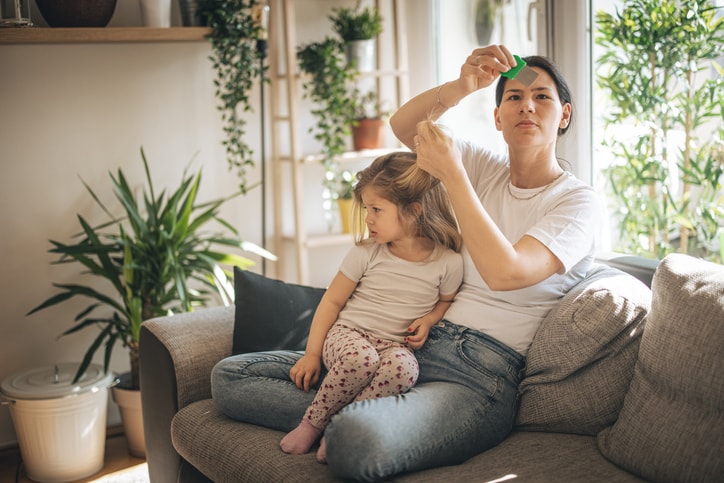Few things can make a parent’s heart race like getting the dreaded “head lice outbreak” letter from their child’s school. In years past, a bout of head lice might cause kids to be isolated, sent home and even forced to miss school for several days. Now, the American Academy of Pediatrics (AAP) advises a different approach to dealing with the all too common problem of head lice. They just updated their lice guidance for the first time since 2015 with a new emphasis on preventing social stigma and psychological stress.
What are the latest guidelines for dealing with head lice?
The AAP’s clinical report on head lice, published online on September 26, breaks down the latest medications used to treat head lice and explains new tips for managing a lice outbreak in school. If a child has head lice, the report advises:
- All members of the household should be checked for lice.
- The child should remain in class but avoid close contact with others.
- School officials should protect the child’s confidentiality.
- Kids should not be restricted from school attendance because of head lice.
The AAP states that screening programs in schools have not been proven to significantly lower the incidence of head lice. Instead, they recommend community outreach and educational programs for families.
They also say school officials should carefully consider whether to notify all classroom parents during an outbreak.
“Some experts argue that, because of the relatively high prevalence of head lice in young school-aged children, it may make more sense to alert caregivers only if a high percentage of children in a classroom are infested,” the report says. “Other experts feel strongly that ‘alert letters’ violate privacy laws, cause unnecessary public alarm, and reinforce the notion that a head lice infestation indicates a failure on the school’s part rather than a community problem.”
So, kids with head lice don’t need to miss school?
Many people assume one case of head lice poses a risk to the entire classroom, but the AAP says this actually isn’t the case. According to the report, lice cannot jump or or hop; they can only crawl. This means transmission has to happen through head-to-head contact, which is more difficult. Even using the same comb or pillow case as a person with head lice doesn’t necessarily mean you will get it, too.
“Lice found on combs are likely to be injured or dead, and a louse is not likely to leave a healthy head unless there is a heavy infestation,” the report says. “In one study, live lice were found on only 4% of pillowcases used by infested persons.”
The AAP also notes that once kids are found to have head lice, it’s likely they’ve already been carrying it for four to six weeks. Forcing them to stay home from school at that point does little to prevent transmission and can result in unnecessary absences, loss of privacy, shame and stigma.
Why it’s important to battle head lice stigma
Despite its reputation, head lice isn’t a sign of poor hygiene or a health hazard, and the AAP says the stigma against head lice may be worse than the critters themselves. Studies show that head lice stigma not only has the potential to hurt students socially, but can also result in financial costs and over-treatment with medications.
In taking a stance against lice-related absences and stringent “no-nit” policies in schools, the AAP aims to reduce the shame and humiliation kids experience when they are diagnosed and treated for lice.
“Head lice are an unpleasant part of the human experience, but they can be successfully managed and are no reason for a child to miss school,” says Dr. Dawn Nolt, the lead author of the report, in a press release. “The AAP encourages pediatricians to serve as an educational resource for families, school districts and communities so that head lice may be treated and managed without stigma.”
So, what should you do if you child has head lice?
Frequently, head lice can be treated at home. Anti-lice creams or shampoos can be purchased over the counter without a prescription. To use an anti-lice shampoo:
- First, wash the hair with regular shampoo and towel dry.
- Pour anti-lice shampoo into damp hair.
- Lather anti-lice shampoo all through hair and down to the roots.
- Leave anti-lice shampoo in for a full 10 minutes or the time specified on the bottle.
- Repeat the process again within nine days.
Kids under 2 should be seen by a doctor before any treatments are used.
If an over-the-counter lice shampoo is ineffective, a pediatrician can help. Parents can contact their child’s doctor to ensure proper diagnosis and treatment any time lice is suspected.






